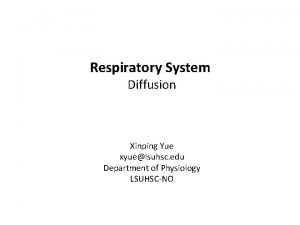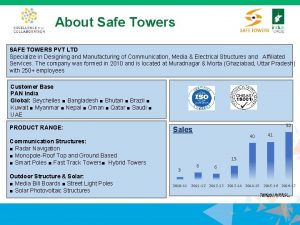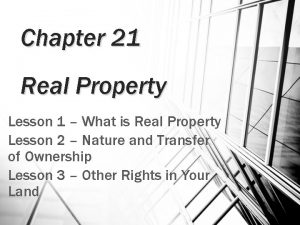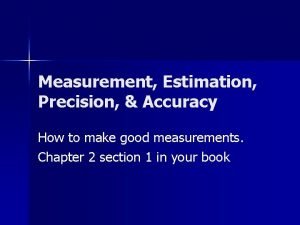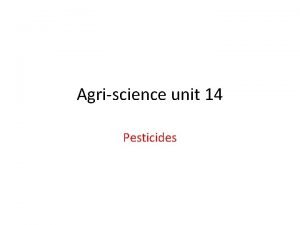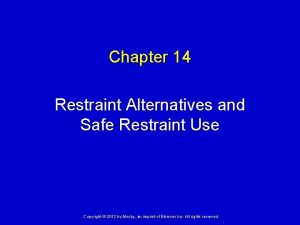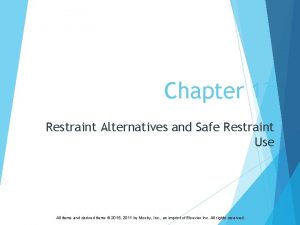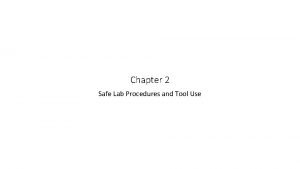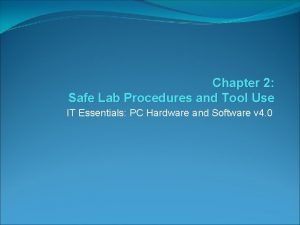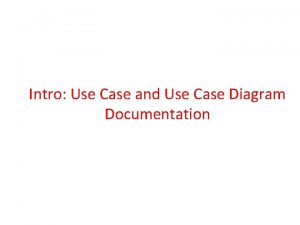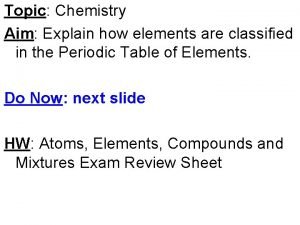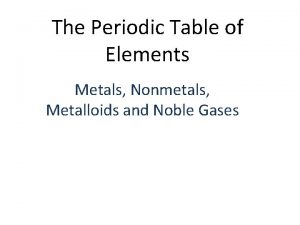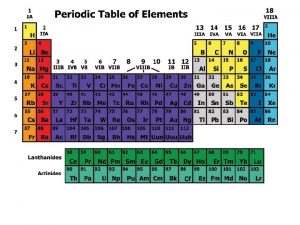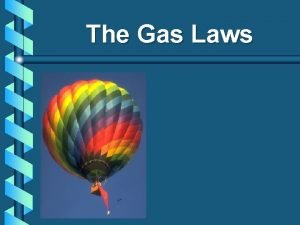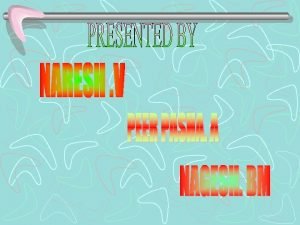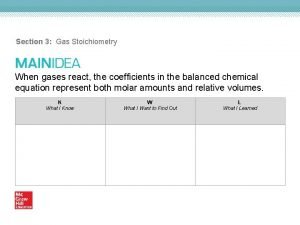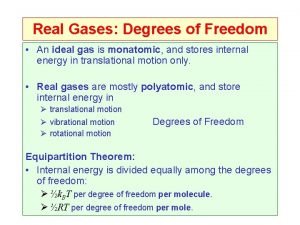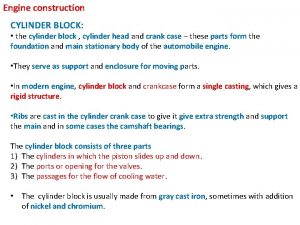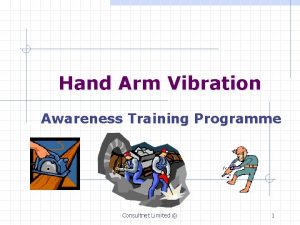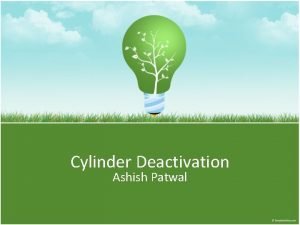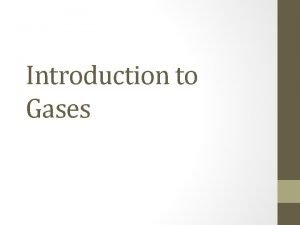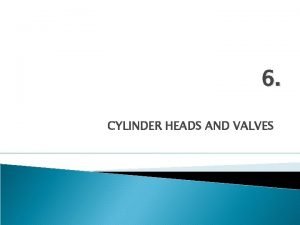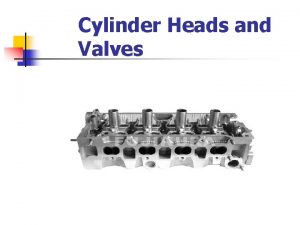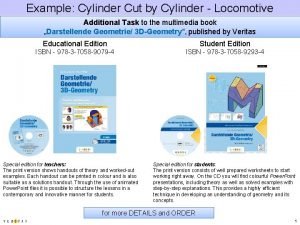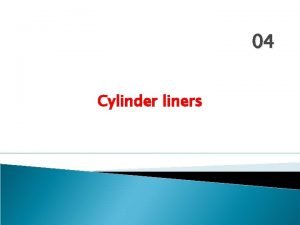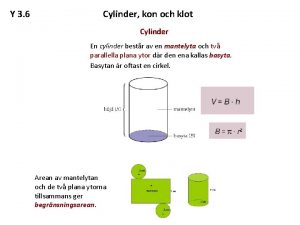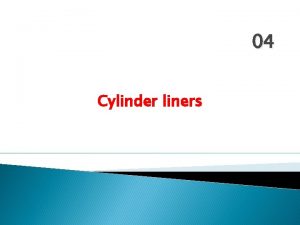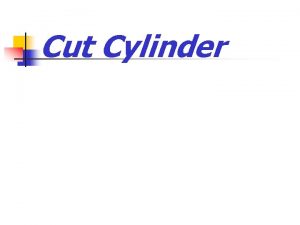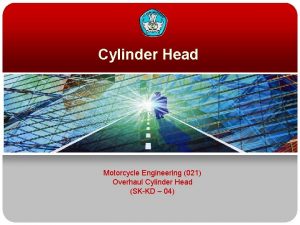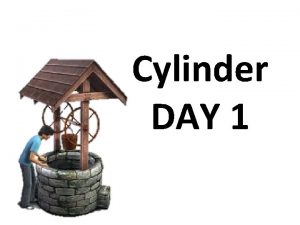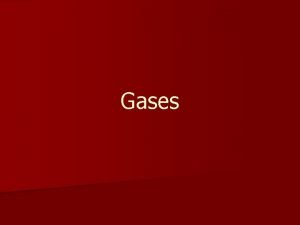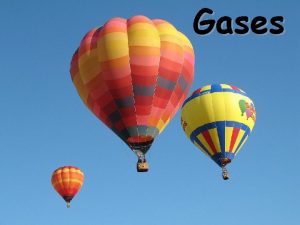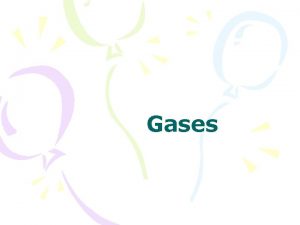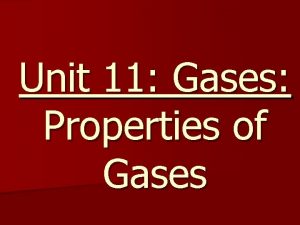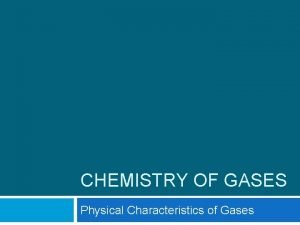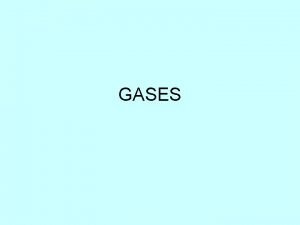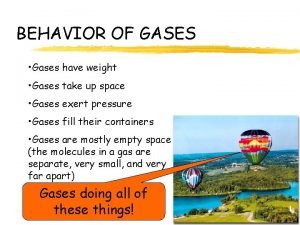Safe Use of Cylinder Gases Consultnet Limited Introduction



























- Slides: 27

Safe Use of Cylinder Gases ©Consultnet Limited

Introduction v Compressed gases used in a variety of industrial and laboratory situations v Compressed gases present a unique hazard. Depending on the particular gas, there is a potential for simultaneous exposure to both mechanical and chemical hazards v Gases can be: – Flammable or combustible – Explosive – Corrosive – Poisonous/toxic – Inert – Cryogenic – Pyrophoric(burns on contact with air) – or a combination of hazards ©Consultnet Limited

Introduction Common Industrial Gases v Oxidants support combustion e. g. air & oxygen v Inerts do not generally react with other materials, asphyxiants(leak displace air) e. g. nitrogen, argon, helium v Flammables when mixed with oxidant and ignition source will burn e. g. acetylene, hydrogen, propane v Toxics toxic in small concentrations e. g. ammonia, chlorine, carbon dioxide v Corrosives react with materials causing reactions e. g. chlorine, sulfur dioxide v Pyrophorics ignite spontaneously in air e. g. silane, phosphine ©Consultnet Limited

Main Causes of Accidents Ø Inadequate training and supervision Ø Poor installation Ø Poor maintenance Ø Faulty equipment and/or design(e. g badly fitting valves or regulators) Ø Poor handling Ø Poor storage Ø Inadequately ventilated working conditions ©Consultnet Limited

Main Hazards Ø Impact from the blast of a gas cylinder explosion or rapid relase of compressed gas Ø Impact from parts of gas cylinders that fail or any flying debris Ø Contact with the released gas or fluid(such as chlorine) Ø Fire resulting from the escape of flammable gas or fluids such as LPG Ø Impact from falling cylinder ©Consultnet Limited

Safe Working with Gas Cylinders: Identification and Properties ü Read the label to see what gas you are dealing with and double check tha the cylinder/gas is right for th eintended use ü No compressed gas cylinder should be accepted for use that does not legibly identify its contents by name ü If the labeling on a cylinder becomes unclear or an attached tag is defaced to the point the contents cannot be identified, the cylinder should be marked "contents unknown" and returned directly to the manufacturer ü Never rely on the color of the cylinder for identification. Color coding is not reliable because cylinder colors may vary with the supplier. Additionally, labels on caps have little value because caps are interchangeable ü If there is a mismatch between the color of a cylinder and the label. Do not use, contact the supplier immediately ü Know the properties of the gas (read Material Safety Data Sheets available from your Supervisor) ü The cylinder’s contents should be identified at all times as well as the cylinder status (full, empty or in service) ©Consultnet Limited

Safe Working with Gas Cylinders Work Practices Ø Ø Ø Ø Securely restrain cylinders to prevent them falling over Close the cylinder valve and replace dust caps when cylinder not in use Before connecting a gas cylinder to equipment or pipework make sure regulator and pipework are suitable for the gas and pressure being used Never drop a gas cylinder Never tamper with cylinders or subject them to abnormal mechanical shocks which could damage the valve or safety device Never re-paint, change markings or identification or interfere with threads Never disguise damage to a cylinder or valve. Label as faulty and contact the supplier Never attempt to repair a cylinder Never scrap a cylinder Never subject cylinders to abnormally high or low temperatures Never mix gases in a cylinder Never try to refill a cylinder unless properly trained to do so Never transport by rolling them on the ground or use them as rollers or supports Never pick them up by magnetic lifting Never subject to abnormal mechanical shocks whuch could damage the valve or safety device ©Consultnet Limited

Safe Working with Gas Cylinders Daily Inspection ØCylinders should be inspected daily and prior to each use for corrosion, leaks, cracks, etc. ØInspection should include the cylinder, piping, safety relief devices, valves, protection caps and stems. ØLeaking regulators, cylinder valves or other equipment should be taken out of service. ©Consultnet Limited

Safe Working with Gas Cylinders ü Maintenance of cylinders and their valves or relief devices shall be performed only by trained personnel. ü An emergency response plan shall be developed and implemented wherever compressed gas cylinders are used, handled or stored. ü Never smoke around compressed gas cylinders. ü Valve protection caps must remain in place at all times except when cylinders are secured and connected to dispensing equipment ü Only wrenches or tools provided by the cylinder supplier should be used to open or close a valve. At no time should pliers be used to open a cylinder valve. ü Never apply PTFE tape, jointing compounds or any other sealing material to the valve in an attempt to achieve a tight seal, if a gas tight seal cannot be achieved metal to metal, replace the regulator or change the cylinder ©Consultnet Limited

Gas Cylinder Use After the regulator is attached, the cylinder valve should be opened just enough to indicate pressure on the regulator gauge (no more than one full turn) and all the connections checked with a soap solution for leaks. Never use oil or grease on the regulator of a cylinder valve. ØBefore a regulator is removed from a cylinder, the cylinder valve shall be closed and the regulator relieved of gas pressure. The valve cap shall be replaced, the cylinder clearly marked as "empty, " and returned to a storage area for pickup by the supplier ØRegulators, gauges, hoses and other apparatus shall not be used on gas cylinders having different chemical properties ØValve outlet thread size is different for different products but the same products from different gas suppliers will have the same thread ©Consultnet Limited

Gas Cylinder Regulators Ø Ø Ø A regulator is a device that receives gas at a high pressure and reduces it to a much lower working pressure Precision instruments and MUST be handled with care to avoid damage to their sensitive springs, diaphragms, valve seals etc. Equipment should display the relevant European/British Standard number and the pressures up to which it can operate Leave the pressure adjustment knob/screw fully out when the regulator is not in use (this ensures a minimum of tension on the springs and diaphragms) Cylinders should be placed with the valve accessible at all times. The main cylinder valve should be closed as soon as it is no longer necessary that it be open, it should never be left open when the equipment is unattended or not operating This is necessary not only for safety when the cylinder is under pressure, but also to prevent the corrosion and contamination resulting from diffusion of air and moisture into the cylinder after it has been emptied. ©Consultnet Limited

Flashback Arrestors v Flashback is the result of mixture of fuel gas and oxygen burning within the hose, flame travels and burns its way towards the gas source at great speed, can result in force of explosion in either cylinder v Flashback arrestors must be fitted on both oxygen and fuel gas regulators v If flashback arrestor is dropped/damaged replace immediately v Flashback arrestors should oinly be used with the gas they are labelled for and the presuure thay are designed for v Comon reasons for flashback: incorrect purging of hose/torch prior to use, incorrect gas pressure, incorrect nozzle, damaged torch valves, gas passages blocked within the torch, kinked or trapped hose ©Consultnet Limited

Hoses ü Correct hose bore size, pressure rating, length and color coding are essential for safety BS EN 559 ü Blue – oxygen, Red - acetylene and other fuel gases(except LPG) ü Black – inert and non combustible gases ü Orange – Liquified Petroleum Gas ü Never use hoses that are longer than necessary ü Never use equipment while hoses are wrapped around the cylinders or trolley ü Length of hose should be suitable for the task ü Keep hoses in good condition ü Examine the hose for cracks, deterioration, damage and test the hose for leaks before use ü Do not repair hoses unless you have the skill and means to test hem in accordance with BS En 1256 ü Purge hose thoroughly before lighting torch ü Do not put wrapping tape around hosing as this contains combustible hydrocarbons ü Do not use copper piping with acetylene hoses as it is potentially explosive ü Protect hosing from heat, oil, grease or mechanical damage ©Consultnet Limited

Piping Ø Distribution lines and their outlets should be clearly labeled as to the type of gas contained Ø Piping systems should be inspected for leaks on a regular basis Ø Special attention should be given to fittings as well as possible cracks that may have developed ©Consultnet Limited

Blow Pipes and Torches Ø Leaks are a serious hazard as they are closest to the operator Ø Always check condition before use, ensure tip is free of obstruction Ø Signs of heat damage around the blow pipe or torch may indicate the equipemnt has sufferd interal damage and is leaking and should be replaced immeidately Ø No sign of sideways movement of the cutting leaver as this could cause gas leaks within the body of the torch that are difficult to detect Ø Always fit the correct size nozzle for the job( hole size and pressure set at regulator determine gas flow and gas velocity exiting the nozzle, manufacturer gives a pressure rating for the nozzle being use, if the gas exit velocity is slower than the combustion velocity backfire and flashback may occur Ø Replace blow pipe or torch if § Broken bent or loose gas control valve § Bent mixer, misshapen cutter head § Bent cutter tube § Broken of bent cutting oxygen lever Ø Leak test all connections and valves prior to use Ø If replacing O ring seals always use the correct materials ©Consultnet Limited

Acetylene Unique properties v Acetylene gas under excess pressure becomes unstable v Cylinders should never be subject to intense heat or physical impact as the rise in temperature and pressure may cause the acetylene to thermally decompose v Prior to moving a cylinder that has been subject to heat or severe impact contact trained emergency personnel who can check for temperature rise and apply correct procedures v The cylinder may appear normal but if it is moved it may detonate with fatal consequences ©Consultnet Limited

Handling Gas Cylinders Ø Wear PPE: gloves, protective footwear, eye protection Ø Correct way to move cylinders is to: keep upright, secure and with valves uppermost Ø Use mechanical aids such as a trolley where reasonably practicable( do a risk assessment) Ø Use suitable cradles, slings, clamps or other effective means when lifting with a hoist or crane Ø For short distances on even ground the practice of ‘milk-churning’ (manually moving cylindres) can be used only by trained personnel and never for longer distances, in uneven ground, wet or icy conditions, poor lighting, or at speed a trolley should be used Ø All personnel involved should have completed manual handling training Ø Never roll cylinders along the ground Ø Never transport cylinder with valve and pressure regulator attached or with the valve open Ø Never attempt to catch a falling cylinder just get out of the way Ø Never lift a cylinder by its cap, valve or guard/shroud Remember that a cylinder is never empty ©Consultnet Limited

Transporting Cylinders Carriage of Dangerous Goods Regulations apply v If possible carry in open vehicles or trailers v If they must be carried in closed vans/cars ensure good ventilation at all times v If the load compartment is not separated from the driver do not carry toxic gas cylinders (those with a toxic gas label and having yellow as a colour on the cylinder) v Secure cylinders properly so they cannot move or fall in transit or do not project beyond the edges of the vehicle, normally in the upright position unless instructions for transport state otherwise v Ensure gas cylinders are clearly labelled to show contents and associated hazards v Fit suitable protective valve caps and covers to cylinders ©Consultnet Limited

Transporting Cylinders Carriage of Dangerous Goods Regulations apply v Disconnect hoses and regulators from cylinders v Carry propane cylinders upright and do not carry flammable gas cylinders in the same compartment as toxic gas cylinders v Do not smoke while carrying cylinders inside vans/cars v Unload the cylinders as soon as possible and move to a well ventilated storage area v If you suspect it is leaking, park the vehicle, investigate the fault and contact the supplier v If you are involved in an accident advise, any emergency services involved what gas cylinders are being carried ©Consultnet Limited

Safe Storage Each Storage area should be subject to unique risk assessment v It is best to store gas cylinders in the open and on concrete in a fenced compound with some weather protection v In storage areas oxygen cylinders must be stored at least 3 metres away/separated by a fire wall from fuel gases such as acetylene, propane, methane etc. v Full cylinders should be stored separately from empties and empty oxygen cylinders should be segregated from empty fuel gas cylinders v Other products should not be stored in the gas storage areas especially not oil or corrosive liquids, sources of ignition or flammable materials v Ease of access into and around storage area, such as provision of aisle >0. 6 m to prevent domino effect v LPG cylinders have special requirements including storage 3 m away from other gases v Pyrophoric and toxic gases should be stored seperately in locked, suitable ventilated storage areas with restricted access v Protect gas cylinders from external heat sources which may adversely affect their mechanical integrity v Cylinders should be secured and properly restrained, secure with straps or chains connected to a wall bracket or other fixed surface, or by use of a cylinder stand v Cylinders should be clearly labelled to show contents and associated hazards ©Consultnet Limited

Safe Storage v Store all cylinders upright and secure on a level surface to prevent them from falling v Acetylene and propane must never be stacked horizontally either in storage or in use v Storage arrangements should ensure turnaround of stock in adequate time v Storage areas with gas cylinders must have more than one exit v Cylinders should be located away from any heat/source of ignition and if possible away from the fire exits, elevators, walkways, building egresses, unprotected platform edges, or in locations where heavy moving objects may strike or fall on them v Storage arrangements should be clearly described in the emergency plan v Storage area must have good housekeeping and adequate warning signs with fire fighting equipment as necessary ©Consultnet Limited

Cylinder Incident Response Report any damaged/leaking cylinder to supplier If a cylinder is leaking but the leak has not ignited and it is safe to do so having considered the gases specific properties: v Eliminate all sources of ignition v Ensure the valve is closed but do not over-tighten it v Put the cylinder in a safe place that is well-ventilated – keep it upright v Mark the cylinder as faulty and not to be used v Warn everyone in the area of the gas leak v Inform the supplier v Ensure the work area is thoroughly ventilated before continuing with any work v If a hydrogen cylinder is involved be aware that hydrogen burns with an invisible flame so seek expert assistance ©Consultnet Limited

Cylinder Incident Response Report any damaged/leaking cylinder to supplier If a cylinder is leaking and it has ignited it could explode v. Call the emergency services and evacuate the area to a minimum distance of 100 metres Where a cylinder has been damaged v If it has been dropped or physically damaged check it for leakage and deal with as for a leaking cylinder v For handling acetylene cylinders should not be moved unless it is clearly established that there is no thermal disassociation v Clearly mark any cylinder that has been exposed to excessive heat or physical impact and contact the supplier ©Consultnet Limited

Cylinder Incident Response If a flashback has occurred: v Close both blowpipe valves oxygen first v Close both cylinder valves v Check the temperature of the acetylene cylinder for thermal decomposition v Check the blowpipe has not overheated v Check the nozzle is not damaged v Open both blowpipe valves oxygen first to vent the system v Unwind the pressure adjustment screw on each pressure regulator v Before starting up again, check the integrity of the whole system ©Consultnet Limited

Cylinder Incident Response Gas Cylinders on Fire Depends on the gas, whether the gas is alight at the cylinder valve or if the cylinder has been subject to severe pressure as a result of the heat from the fire. Nature of hazard will determine procedure to be applied v If cylinder has been involved in fire do not approach, evacuate the area to 100 m minimium to 300 m v Call fire brigade v Use large quantities of water to cool the cylinders if safe to do so (do not aim high pressure water direct at the cylinders) from a safe location and await the arrival of trained emergency personnel (Emergency plan training should address) v Remove any cylinders not involved in fire to safe place, ensure valves are closed if safe to do so v Inform gas supplier, v If cylinder contents are unknown, treat as acetylene ©Consultnet Limited

In Your Workplace Look Out for Gas Cylinders: Ø Ø Ø In horizontol position/on the ground In contact with electrical cords Not protected from falling – chain not secure Damaged In an area where could be subject to impact such as near operating forklift Ø Stored near combustibles Ø Oxygen and acetylene stored together Ø Without valve caps Deal with these Hazards IMMEDIATELY ©Consultnet Limited

Conclusions Ø Compressed gases present a unique hazard. Depending on the particular gas, there is a potential for simultaneous exposure to both mechanical and chemical hazards Ø Inadequate training and supervision, poor installation, poor maintenance, faulty equipment and/or design(e. g badly fitting valves or regulators), poor handling, poor storage, inadequately ventilated working conditions Ø When working with compressed gases you need to know the properties of the gas, safe use procedures and what to do when things go wrong Ø For detailed use of individual gases you should now review the relevant Material Safety data Sheet (MSDS) for each gas used on your site Always Treat Gas Cylinders with Respect For additional information which could be used as presentation handouts visit UK HSE information on Gas Safety for a whole series of leaflets on the topic ©Consultnet Limited
 Perfusion limited vs diffusion limited
Perfusion limited vs diffusion limited How to transpose eye prescription
How to transpose eye prescription Safe towers pvt. ltd
Safe towers pvt. ltd Safe feed safe food
Safe feed safe food Safe people safe places
Safe people safe places Irrevocable rights to some limited use of another's land
Irrevocable rights to some limited use of another's land What measurement does a graduated cylinder use
What measurement does a graduated cylinder use Agriscience unit 14 completion answers
Agriscience unit 14 completion answers Restraint alternatives and safe restraint use
Restraint alternatives and safe restraint use Restraint alternatives are
Restraint alternatives are Safe lab procedures
Safe lab procedures Safe lab procedures and tool use
Safe lab procedures and tool use Yesterday
Yesterday Definisi use case diagram
Definisi use case diagram Sistema termodinamico
Sistema termodinamico Atomic mass number of boron
Atomic mass number of boron Thermal expansion and contraction examples
Thermal expansion and contraction examples Periodic table metals nonmetals metalloids noble gases
Periodic table metals nonmetals metalloids noble gases Gases on the periodic table
Gases on the periodic table Greenhouse gases are good or bad
Greenhouse gases are good or bad Are gasses highly compressible
Are gasses highly compressible The atmosphere is a mixture of ___________.
The atmosphere is a mixture of ___________. Buoyancyability
Buoyancyability Stoichiometry of gases
Stoichiometry of gases Venn diagram gas liquid solid
Venn diagram gas liquid solid Gas exchange oxygen transport
Gas exchange oxygen transport Degree of freedom of an ideal gas
Degree of freedom of an ideal gas Equação geral dos gases
Equação geral dos gases
